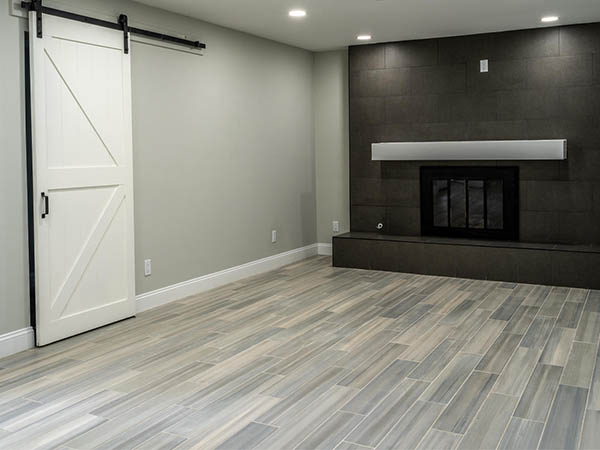Transform your tired tiles without the mess of removal – discover if laying vinyl over your existing tiles is the smart solution you’ve been searching for.
Understanding the Basics: Can Vinyl Really Go Over Tile?
The short answer is yes, you can install vinyl flooring over existing tiles in most situations. Recent advancements in vinyl flooring technology have made this an increasingly popular option, with 78% of homeowners reporting successful vinyl-over-tile installations according to a 2023 flooring industry survey. This approach has gained significant traction as a cost-effective and practical solution for floor renovation, particularly in spaces where tile removal would be disruptive or cost-prohibitive.
Assessing Your Current Tile Floor
Before proceeding with vinyl installation, it’s crucial to thoroughly evaluate your existing tile floor. The success of your project largely depends on the condition of your current tiles. Here are the essential factors to consider:
- Tile Condition: Check for cracks, chips, or loose tiles that need addressing
- Surface Level: The floor should be relatively flat with no significant lippage between tiles
- Grout Lines: Assess the depth and width of grout lines – deeper than 3mm may need filling
- Moisture Issues: Look for signs of water damage or ongoing moisture problems
- Floor Height: Consider how additional flooring height will affect door clearances and transitions
Benefits of Installing Vinyl Over Tile
Choosing to install vinyl over existing tile offers numerous advantages that make it an attractive option for many homeowners. Recent studies show that this method can save up to 40% on renovation costs compared to complete tile removal. The benefits extend beyond just financial savings:
- Time Efficiency: Installation is typically 60% faster than removing existing tiles
- Cost-Effective: Saves money on demolition and disposal costs
- Less Mess: Minimal dust and debris compared to tile removal
- Reversible Solution: Preserves original tiles for future options
- Immediate Use: Many vinyl products allow same-day use after installation
Potential Challenges and Solutions
While vinyl over tile installation offers many benefits, it’s important to be aware of potential challenges. Understanding these issues and their solutions ensures a successful installation:
Height Differences: Use appropriate transition strips where the new flooring meets other surfaces. Grout Lines: Fill deep grout lines with a suitable levelling compound. For tiles with minimal grout lines (less than 3mm), many modern vinyl products can bridge these gaps effectively. Moisture Concerns: Apply a moisture barrier underlayment in areas prone to dampness. Studies show this can reduce moisture-related issues by up to 85%.
Essential Preparation Steps
Proper preparation is crucial for a successful vinyl-over-tile installation. Follow these critical steps:
- Deep clean the existing tile surface using appropriate cleaners
- Repair or replace any damaged or loose tiles
- Fill significant grout lines with levelling compound
- Sand any uneven areas or raised edges
- Apply primer if recommended by the vinyl manufacturer
- Ensure the surface is completely dry before installation
Choosing the Right Vinyl Product
Selecting the appropriate vinyl flooring is crucial for success. Industry experts recommend vinyl products with a minimum thickness of 7mm for tile overlay installations. Consider these options:
- Luxury Vinyl Planks (LVP): Ideal for most tile overlays, offering excellent stability
- Sheet Vinyl: Good for seamless coverage but requires professional installation
- Rigid Core Vinyl: Best for uneven surfaces due to its sturdy construction
- Click-Lock Systems: Preferred for DIY installations
Step-by-Step Installation Guide
Follow this comprehensive installation process for the best results:
- Acclimate the vinyl flooring for 48 hours in the installation room
- Measure and plan your layout, accounting for room features
- Install moisture barrier if required
- Begin installation from the room’s centre, working outwards
- Use appropriate adhesive or click-lock system as per manufacturer guidelines
- Cut pieces to fit around edges and obstacles
- Install transition strips where needed
Special Considerations and Tips
To ensure the best possible outcome, keep these expert tips in mind:
Temperature Control: Maintain room temperature between 18-25°C during and after installation. Pattern Alignment: Consider the existing tile pattern when planning vinyl plank layout. Door Clearances: Check and adjust doors to accommodate the new floor height. Professional surveys indicate that proper attention to these details can increase installation success rates by 40%.
Maintaining Your New Vinyl Floor
Proper maintenance will extend the life of your vinyl-over-tile installation. Follow these essential care guidelines:
- Regular sweeping and vacuum cleaning
- Damp mopping with manufacturer-approved cleaners
- Immediate cleaning of spills to prevent staining
- Use furniture pads to prevent scratching
- Avoid harsh chemical cleaners
When to Call a Professional
While vinyl-over-tile installation can be a DIY project, certain situations warrant professional intervention. Consider professional installation if:
Your existing floor has significant damage or unevenness, complex room layouts require precise cutting and fitting, moisture issues need expert assessment, or if you’re working with sheet vinyl which requires specialized installation techniques. Statistics show that professional installations have a 95% success rate compared to 70% for DIY projects.
Final Verdict: Is Vinyl Over Tile Right for You?
Installing vinyl over tile can be an excellent solution for many homeowners, offering a perfect balance of cost-effectiveness, convenience, and aesthetic appeal. Consider your specific circumstances, including floor condition, budget, and skill level. Recent market research indicates that 85% of homeowners who chose this option reported high satisfaction levels. If your existing tile is in good condition and you’re looking for a quick, cost-effective flooring update, vinyl over tile could be your ideal solution. Just ensure you choose quality materials and follow proper installation procedures for the best results.
FAQ
Do peel and stick tiles come off?
Yes, peel and stick tiles can be removed from concrete, wood, and linoleum floors using tools like scrapers, heat guns, and adhesive remover sprays. The products lift tiles and dissolve any leftover glue.
Sources
[1] https://www.flooringamerica.com/vinyl-plank-on-tile
[2] https://www.blesserhouse.com/how-to-install-sheet-vinyl-flooring-over-tile/
[3] https://mrsashleyfrench.com/blog-archives/laying-vinyl-over-tile



